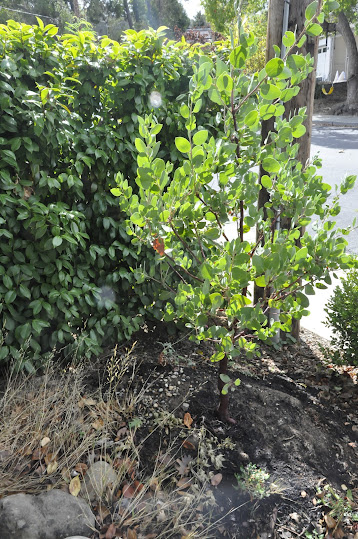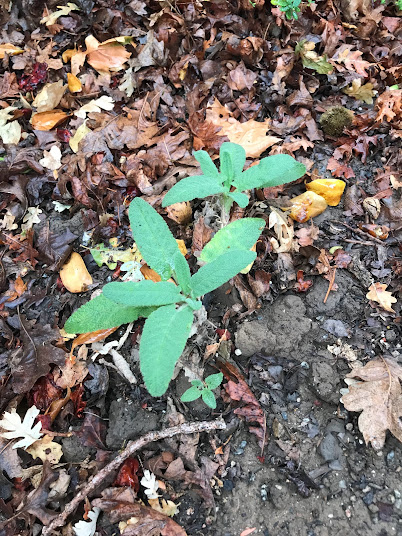The Bring Back Bay Area Bees Butterflies & Birds Garden
In January of 2021, we removed our lawn and started planting drought tolerant California native plants. These native plants co-evolved with other native species over thousands of years. In the process, they became the only source of food for the caterpillars that feed baby birds, and serve as the foundation for the bulk of our local ecosystem. We were inspired by Doug Tallamy's lecture, "Nature's Best Hope" (also a NY Times bestselling book) You can read more about this in my welcome post, and watch his video here: https://bit.ly/Tallamy-CAPlants
Fast forward to today, with unexpected rains that provided a reminder that the fall native California planting season is just around the corner. This inspired me to do a bit of weeding in between the showers and start to imagine the next steps for each garden area. Since we started over a year and a half ago, the front yard has been transformed from lackluster lawn to four garden 'rooms':
Lawn (removed 11/25/21 - thank you, Doug Tallamy for the inspiration!)Chilean jasmine (removed 9/13/22) Pierris japonicus (removed 10/2/22)Sarcaccoca humulis (removed 10/2/22)Japanese Maples - by house (removed 11/15/22)Box hedge (removed 1/15/23)
1) The Courtyard Garden between the sidewalk and driveway
In the foreground, manzanita Louis Edward and to the left of it, a delicate grey California fuchsia. Behind the chairs, flowering currants and carpenteria replaced non-native maples (the trees we removed not only do not feed any species, they were also a fire hazard so close to the house). Note that there are maples native to California that do feed the ecosystem: Home > Maple (all) for California (calscape.org)
California Fuchsia - Salmon colored variety, possibly Sierra Salmon; these, and most red tubular native flowers, are hummingbird magnets. Since bees don't use red flowers generally, these have much more nectar for the hummingbirds.
Red Flowering Buckwheat waiting to get planted. Buckwheat flowers attract a wide variety of insects, the leaves host many species of butterflies. More info is here: Red-flowered Buckwheat, Eriogonum grande var. rubescens (calscape.org)
2) The Meadow on the left and, 3) The Swale Garden on the right, both on the other side of the sidewalk
This beautiful ancient Valley Oak (Quercus lobata) has nourished this land for centuries. The leaves feed the soil and protect thousands of insects that feed the birds, salamanders and many other species. The acorns feed deer, racoons, squirrels and thousands more insects. We saw a hummingbird hovering near this oak, its tiny tongue flicking gnats out of the air. We subsequently learned that 80% of a hummingbird's diet is insects, which are also the primary food source for its babies.
Red Flowering Currant (Ribes sanguineum) in foreground, with native asters (Aster chilensis) in between following the curve of the swale
The gorgeous Fuchsia-flowered Gooseberry (Ribes speciosum) is beloved by hummingbirds for its nectar and many other birds for its berries.
It is tucked into a quiet corner of the swale garden, as its thorns are not beloved by humans. It is a nice plant for places where you want
to discourage people/dogs/or anything else that might trample your garden.
Manzanita "Dr. Hurd" underplanted with red flowering buckwheat in the Swale Garden
Close up of Pacific Asters (Symphyotrichum chilense) in the Swale Garden
- these are a bee magnet!
California native Woodland Strawberry (Fragaria vesca) in the Swale Garden
Elsewhere we have Beach Strawberry (Fragaria chiloensis) that prefers
a bit more sun.
4) The Cafe Garden adjacent to the front door:
To the right in the picture above are the native plants that are just becoming established this year. To the left are well established non-natives: in the foreground is Pieris japonica (from Japan), and on the other side of the birdbath is Sarcococca humilis (from China/India). I love these plants, and look forward to seeing them someday in their native countries, feeding the caterpillars and other insects that build the food webs in those local ecosystems. In the meantime, I need to remove them to make room for plants that will feed mine.
Coffeeberry "Eve Case" - this compact coffeeberry feeds many species of butterflies and moths, and does well in shade
Hummingbird sage seedlings - these do well in the shade of oak trees and are very popular with hummingbirds and bees
Birdbath with rocks for bees and butterflies
This is another view of the Cafe Garden: California natives include Coffeeberry, Hummingbird Sage, three Dark Star Ceanothus, and Dutchman's Pipevine seedlings along the trellis. Non-native azalea is in bloom. In the distance part of the Swale Garden is visible. Note: Dutchman's Pipevine is the only host plant for the caterpillars of the gorgeous Pipevine Swallowtail butterfly. It loves shade so will hopefully do well here. Learn more here: Pipevine Swallowtail, Battus philenor (calscape.org)
As I buzzed through each of these garden rooms, tidying up, I was amazed at some of the changes we've seen in just a year and a half. For instance, this past year was the first time we followed the Xerces Society's guidelines to "Leave the Leaves" - just sweeping them from hard surfaces, and from the 'meadow' and into piles around our plants. https://bit.ly/Leave-the-Leaves
This serves to provide habitat for thousands of insects, including butterfly and moth pupae, that feed birds (especially the babies). The decomposing leaves also put nutrients back into the soil, soften the native clay so it is easier to pull weeds, and breed beneficial mycorrhiza - a fungus that live in plant roots and provides essential micronutrients, helps with water absorption, and secretes chemicals to kill soil pathogens. You can read more about it here: Planting Guide (calscape.org).
I had to pull very few weeds today, and the ones that I did pull came up easily as the ground was soft. In contrast, the ground in the meadow where we removed leaves was as hard as a rock and I'll need to use a hoe to get the weeds out. There are thousands more insects that flit up when I disturb any space in the garden, such as pulling the few weeds that showed up. And as a result, I'm seeing more birds.
The leaves also provided a nice environment for acorns to germinate so we have some oaks popping up around the yard. I'm going to leave some of these in place as they may someday replace the ancient Valley Oak we have in the garden now. Doug Tallamy also mentioned coppicing oaks, which is more commonplace in the Eastern United States. It keeps them smaller but still provides food to the ecosystem. https://bit.ly/Nature-of-Oaks
I'm looking forward to starting some more seeds and trying out some more plants in each of these garden rooms. It is exciting to see the birds, bees and butterflies start to increase as we add more natives and walk away from the stressful and noisy mow and blow approach to gardening that we had in the past.
We've surpassed our goal of having at least 70% native plants by volume, and are closer to 99%. Here is the current plant list:
California Native Plants:
Trees:
Valley Oak (Quercus lobata)
Blue Elderberry (Sambucus mexicana)
Redbud (Cercis occidentalis) Wegman's Nursery (lg); Watershed Nursery (sm).
Toyon (Heteromeles arbutifolia "Davis Gold") - grown from seed
Toyon (Heteromeles arbutifolia) CNL Nursery
Shrubs:
Ribes:
Red Flowering Currant (Ribes sanguinium) CNL Nursery / Wegman's Nursery
Catalina Currant (Ribes viburnifolium) - Summerwinds Nursery
Golden Currant (Ribes aureum) - Watershed Nursery
Fuchsiaflower Gooseberry (Ribes speciosum)
Manzanita
Arctostaphylos manzanita "Dr. Hurd" - Wegman's Nursery
Arctostaphylos bakeri "Louis Edmund" - Summer Winds Nursery
Arctostaphylos edmundsii "Carmel Sur" - Yerba Buena Nursery
Arctostaphylos Pacific Mist - California Native Landscapes (CNL) Nursery
California Lilac
Ceanothus "Dark Star" - Wegman's Nursery / CNL Nursery
Ceanothus (white) - CNL Nursery
Coffeeberry (Frangula californica "Eve Case") - Summer Winds Nursery
Coffeeberry (Frangula californica "Mound San Bruno") - CNL Nursery
Monkeyflower (Diplacus aurantiacus) - Yerba Buena Nursery
Sages:
Hummingbird Sage (Salvia spathacea) CNPS - SCV Nursery
Black Sage (Salvia mellifera) - Regional Botanic Garden
Salvia "Pozo Blue" (a hybrid of s. clevelandii and s. leucophylla) - gift
Cleveland Sage (Salvia clevelandii) - gift
Perennials:
Bee Plant (Scrophularia californica) - CNPS - SCV Nursery
Blue Eyed Grass (Sisyrinchium bellum) - Wegman's Nursery
California Fuchsia (Epilobium canum) - Murphy's Nursery
California Hedgenettle (Stachys bullata) - Yerba Buena Nursery
Cliff Maids (Lewisia cotyledon) - Yerba Buena Nursery; Summerwinds Nursery
Foothill Penstemmon (Penstemon heterophyllus) - Wegman's Nursery
Iris (Iris "Pacific Coast") - Regional Botanic Park Nursery
Island Alum Root (Heuchera maxima) - CNL Nursery; Summerwinds Nursery
Pacific Aster (Symphyotrichum chilense) - Murphy's Nursery
Red Flowered Buckwheat (Eriogonum grande var. rubescens) - Yerba Buena Nursery
Soap plant (Chlorogalum pomeridianum) - Native Here Nursery
Verbena (Verbena lilacina "De La Mina") - CNL Nursery
Wooly Blue Curls (white version) (Trichostema lanatum) - CNL Nursery
Yampah (Perideridia kelloggii) - Native Here Nursery
Ground Covers:
Yerba Buena (Clinopodium douglasii) - Yerba Buena Nursery
Woodland Strawberry (Fragaria vesca) - Yerba Buena Nursery / Summerwinds Nursery
Beach Strawberry (Fragaria chiloensis) - friend's garden
Sand Dune Sedge (Carex pansa) - Summerwinds Nursery Palo Alto
Vines:
Dutchman's Pipevine (Aristolochia californica) - Yerba Buena & CNL Nurseries
Hairy Honeysuckle (Lonicera hispidula)
Grasses:
Meadow Barley (Hordeum brachyantherum)
Purple needle grass (Stipa pulchra) - Regional Botanic Park Nursery
Mendocino Reedgrass / Leafy Reedgrass (Calimagrostis foliosa) - CNL Nursery
From Seed:
California poppies (Eschscholzia californica) - Larner Seeds
Elegant Clarkia (Clarkia unguiculata) - Larner Seeds
Tidy Tips (Layia platyglossa) - Larner Seeds
Non-Native:
Azelea (bird cover, will remove when ceanothus and coffeeberry mature)
Japanese Maple - (by oak, used as bird perch, will remove when toyons mature)
Camelia - by window, used as bird perch; will remove when sambucus matures
Lavender (popular bee and hummingbird nectar source; seeds for finches, keeping it)




















Comments
Post a Comment
Please Leave a Reply